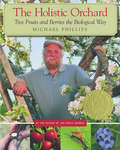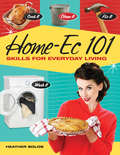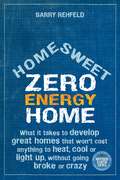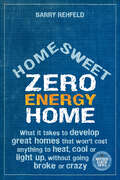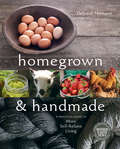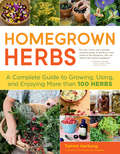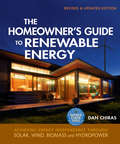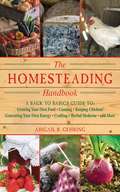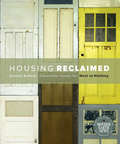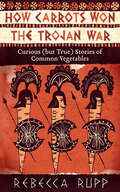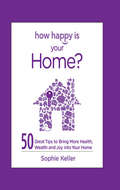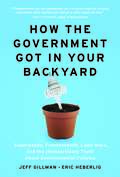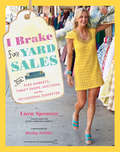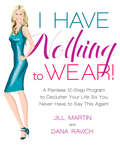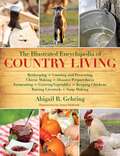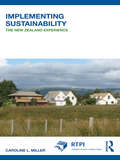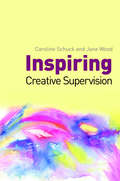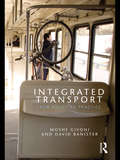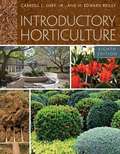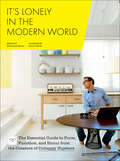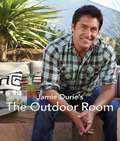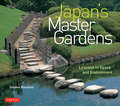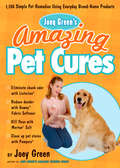- Table View
- List View
The Holistic Orchard
by Michael PhillipsMany people want to grow fruit on a small scale but lack the insight to be successful orchardists. Growing tree fruits and berries is something virtually anyone with space and passionate desire can do - given wise guidance and a personal commitment to observe the teachings of the trees. A holistic grower knows that producing fruit is not about manipulating nature but more importantly, fostering nature. Orcharding then becomes a fascinating adventure sure to provide your family with all sorts of mouth-watering fruit. The Holistic Orcharddemystifies the basic skills everybody should know about the inner-workings of the orchard ecosystem, as well as orchard design, soil biology, and organic health management. Detailed insights on grafting, planting, pruning, and choosing the right varieties for your climate are also included, along with a step-by-step instructional calendar to guide growers through the entire orchard year. The extensive profiles of pome fruits (apples, pears, asian pears, quinces), stone fruits (cherries, peaches, nectarines, apricots, plums), and berries (raspberries, blackberries, blueberries, gooseberries, currants, and elderberries) will quickly have you savoring the prospects. Phillips completely changed the conversation about healthy orcharding with his first bestselling book,The Apple Grower, and now he takes that dialogue even further, drawing connections between home orcharding and permaculture; the importance of native pollinators; the world of understory plantings with shade-tolerant berry bushes and other insectary plants; detailed information on cover crops and biodiversity; and the newest research on safe, homegrown solutions to pest and disease challenges. All along the way, Phillips' expertise and enthusiasm for healthy growing shines through, as does his ability to put the usual horticultural facts into an integrated ecology perspective. This book will inspire beginners as well as provide deeper answers for experienced fruit growers looking for scientific organic approaches. Exciting times lie ahead for those who now have every reason in the world to confidently plant that very first fruit tree!
Home-Ec 101: Skills for Everyday Living
by Heather Solos Jacqueline MusserReal Skills for Real Life From keeping your home clean and in good repair to preparing your own food, self-sufficiency rocks. Having an understanding of the domestic arts gives you a sense of control over your life. These skills also help you save money, not by chasing deals, but by teaching the principle of the mantra: Use it up, wear it out, make it do, or do without. Life skills are the essence of frugality. Whether you just moved out of your parent's basement or you cut the apron strings a while ago, you'll learn the skills you need to manage your household. Inside you'll find: Quick, easy cleaning solutions for every room of the house, so you can get the job done and get on with life Instructions for removing stubborn stains and offensive odors from fabric Simple fixes to wardrobe malfunctions including broken zippers, missing buttons, and fallen hemlines Troubleshooting advice for common problems with home appliances A minimum home maintenance guide to prevent or catch major repair problems A basic plumbing tutorial that includes clearing and preventing clogs, stopping a running toilet and retrieving items dropped down a drain Ideas for healthy and fast meal planning so you can start cooking and stop relying on takeout or preservative-packed convenience food Definitions of common cooking terms and techniques found in recipes Plans for stocking a pantry so you can make dinner (even if you haven't been grocery shopping in a week) and be prepared when disaster strikes A complete rundown of essential kitchen equipment from knives to pans to small appliances Equip yourself with the skills you need for everyday life.
Home Sweet Zero Energy Home: What It Takes to Develop Great Homes That Won't Cost Anything to Heat, Cool or Light Up, without Going Broke or Crazy
by Barry RehfeldZero energy buildings produce at least as much energy as they consume through a combination of efficiency design and renewable technologies. Home sweet zero energy home shows how developing a better more environmentally friendly home doesn't have to break your back or your bank account.
Home Sweet Zero Energy Home (Mother Earth News Books for Wiser Living)
by Barry RehfeldZero energy homes produce at least as much energy as they consume through a combination of energy efficiencies, passive design, and renewable energy production. California has adopted zero net energy as the new residential standard for 2020; many other governments are considering similar policies. Developing zero energy homes is the first step towards making all buildings zero energy-a critical step in mitigating climate change, since buildings account for forty percent of material and energy use worldwide.Home Sweet Zero Energy Home is the first practical guidebook that clearly shows how zero energy homes can be good, livable, affordable homes. The author identifies all the pieces of the zero energy puzzle and how they fall into place, and explains how homeowners and buyers can also take smaller steps towards sharply reducing the energy use of existing buildings. Focusing on real costs and savings, this book takes an in-depth look at:*Site selection and passive design*Insulation, windows, doors, and building materials*Heating and cooling*Appliances and electronics*Financial resources and incentivesWhether you are a prospective buyer, owner, or developer, Home Sweet Zero Energy Home is your complete guide to creating a more comfortable, efficient, environmentally friendly home without breaking your back or your bank account.Barry Rehfeld has been a journalist for over thirty years and is the founder of the website Zero Energy Intelligence, where he writes about everything you need to know to build, buy, or renovate a home that produces as much energy as it uses.
Homegrown and Handmade
by Deborah NiemannOur food system is dominated by industrial agriculture and has become economically and environmentally unsustainable. The incidence of diet-related diseases, including obesity, diabetes, hypertension, cancer, and heart disease, has skyrocketed to unprecedented levels. Whether you have forty acres and a mule or a condo with a balcony, you can do more than you think to safeguard your health, your money, and the planet.Homegrown and Handmade shows how making things from scratch and growing at least some of your own food can help you eliminate artificial ingredients from your diet, reduce your carbon footprint, and create a more authentic life. Whether your goal is increasing your self-reliance or becoming a full-fledged homesteader, it's packed with answers and solutions to help you:*Take control of your food supply from seed to plate*Raise small and medium livestock for fun, food, and fiber*Rediscover traditional skills to meet more of your family's needs than you ever thought possibleThis comprehensive guide to food and fiber from scratch proves that attitude and knowledge is more important than acreage. Written from the perspective of a successful self-taught modern homesteader, this well illustrated, practical, and accessible manual will appeal to anyone who dreams of a simpler life.Deborah Niemann is a homesteader, writer, and self-sufficiency expert who presents extensively on topics including soapmaking, bread baking, cheesemaking, composting, and homeschooling. She and her family raise sheep, pigs, cattle, goats, chickens, and turkeys for meat, eggs, and dairy products, while an organic garden and orchard provides fruit and vegetables.
Homegrown Herbs: A Complete Guide to Growing, Using, and Enjoying More than 100 Herbs
by Tammi HartungEnjoy a thriving, fragrant herb garden and use your harvest to bring beauty, flavor, and health to your everyday life. Tammi Hartung provides in-depth profiles of 101 popular herbs, including information on seed selection, planting, maintenance, harvesting, and drying. Hartung also shows you how to use your herbs in a variety of foods, home remedies, body care products, and crafts. Whether you&’re a seasoned herbalist or planting your first garden, Homegrown Herbs will inspire you to get the most out of your herbs.
The Homeowner's Guide to Renewable Energy: Achieving Energy Independence through Solar, Wind, Biomass and Hydropower (Mother Earth News Books for Wiser Living)
by Dan ChirasThe Homeowner's Guide to Renewable Energy shows home and business owners how to make dramatic improvements in energy efficiency and tap into clean, affordable sources of renewable energy for heating, cooling, and generating electricity. This fully revised and updated edition includes expanded coverage of all areas, the latest advances in technology, and the economics of renewable energy systems.
The Homesteading Handbook: A Back to Basics Guide to Growing Your Own Food, Canning, Keeping Chickens, Generating Your Own Energy, Crafting, Herbal Medicine, and More (Handbook Series)
by Abigail R. GehringWith the rapid depletion of our planet's natural resources, we would all like to live a more self-sufficient lifestyle. But in the midst of an economic crisis, it's just as important to save money as it is to go green. As Gehring shows in this thorough but concise guide, being kind to Mother Earth can also mean being kind to your bank account! It doesn't matter where your homestead is located--farm, suburb, or even city. Wherever you live, The Homesteading Handbook can help you: Plan, plant, and harvest your own organic home garden. Enjoy fruits and vegetables year-round by canning, drying, and freezing. Build alternate energy devices by hand, such as solar panels or geothermal heat pumps. Differentiate between an edible puffball mushroom and a poisonous amanita. Prepare butternut squash soup using ingredients from your own garden. Conserve water by making a rain barrel or installing an irrigation system. Have fun and save cash by handcrafting items such as soap, potpourri, and paper. Experience the satisfaction that comes with self-sufficiency, as well as the assurance that you have done your part to help keep our planet green. The Homesteading Handbook is your roadmap to living in harmony with the land.
Housing Reclaimed
by Jessica KellnerHousing is a fundamental human right. For most of human history, our homes were built by hand from whatever local materials were available. However, since the Industrial Revolution, most housing has become little more than quickly constructed, mass-produced, uniform boxes. At the same time, the invention and standardization of the thirty-year mortgage and our ever-increasing reliance on credit has come to mean that most of us never own our homes outright.Housing Reclaimed is a call to arms for nonconventional home builders. It examines how technological advances, design evolution, and resourceful, out-of-the-box thinking about materials and efficiency can help us meet the challenge of building affordable, environmentally friendly, beautiful, and unique homes. Focusing on the use of salvaged and reclaimed materials, this inspirational volume is packed with case studies of innovative projects including:*Phoenix Commotion-working together towards low-income home ownership through sweat equity and 100 percent recycled materials*HabeRae-revitalizing neighborhoods by creating urban infill using modern technology and sustainable and reclaimed materials*Builders of Hope-rescuing and rehabilitating whole houses slated for demolitionThese projects and others like them demonstrate that building one's own home does not have to be an unattainable dream. This beautifully illustrated guide is a must-read for anyone interested in creating quality zero- or low-debt housing, reducing landfill waste, and creating stronger communities.Jessica Kellner is the editor of Natural Home and Garden magazine and a passionate advocate of using architectural salvage to create aesthetically beautiful, low-cost housing.
How Carrots Won the Trojan War: Curious (but True) Stories of Common Vegetables
by Rebecca RuppDiscover why Roman gladiators were massaged with onion juice before battle, how celery contributed to Casanova’s conquests, how peas almost poisoned General Washington, and why some seventeenth-century turnips were considered degenerate. Rebecca Rupp tells the strange and fascinating history of 23 of the world’s most popular vegetables. Gardeners, foodies, history buffs, and anyone who wants to know the secret stories concealed in a salad are sure to enjoy this delightful and informative collection.
How Happy Is Your Home?
by Sophie KellerChange your home...for the happier.With these 50 tips, you'll learn how to apply the principles of feng shui to make your home a healthier, happier place to live. Discover:- How to bring more love in through your front door.- Simple office solutions that will increase your income.- Where to place your bed for better sex and better sleep.Take charge of your happiness, one tip at a time.
How the Government Got in Your Backyard: Superweeds, Frankenfoods, Lawn Wars, and the (Nonpartisan) Truth About Environmental Policies
by Jeff Gillman Eric HeberligBiotechnology—the future or a genetic time bomb? Renewable fuels—the key to cleaner air or just corporate welfare? Greenhouse gasses—baking the earth to death or just a needless worry? Plant patents—improving gardens and farms or just profiteering? When you stop to think about it, the government has its hand in every important environmental issue. And with the left and the right raucously disagreeing about whether the government’s policies are for good or for evil, it’s impossible for a concerned citizen to know what to think.How the Government Got in Your Backyard distills the science, the politics, and the unbiased, nonpartisan truth behind hot-button environmental issues from pesticides to global warming. By clearly representing what the left says, what the right says, what the science is, and what the facts are, Gillman and Heberlig don’t set out to provide the answer—they light the path so concerned citizens can uncover their own true and informed opinion. In this season of political discontent, the unbiased truth about environmental policies—free of political agendas—is as refreshing as it is fascinating.How the Government Got in Your Backyard is not for Republicans or Democrats, liberals or conservatives. It’s for anyone who is ready to get to the bottom line.
I Brake for Yard Sales: And Flea Markets, Thrift Shops, Auctions, and the Occasional Dumpster
by Lara SpencerThe New York Times bestseller by the host of HGTV’s Flea Market Flip, packed with expert tips for bargain-hunting home decorators.Former Good Morning America and Antiques Roadshow host Lara Spencer is a self-confessed frugalista with a passion for shopping at yard sales, thrift shops, and estate sales, and for decorating her home—and friends’ homes—with her fabulous finds. In I Brake for Yard Sales, Lara shares her secrets for bargain hunting and tells you where to shop, what to look for, how to pay for it, how to restore it, and finally, where to put it in your house. Peppered with wisdom from world-renowned appraisers as well as contributions from well-known designers, this book also features the house of comedienne and good friend Kathy Griffin, which Spencer herself refurbished and decorated.
I Have Nothing to Wear!: A Painless 12-Step Program to Declutter Your Life So You Never Have to Say This Again!
by Jill Martin Dana RavichYou know the feeling: the anxiety, the dread, and the utter certainty that in spite of all of the options in the overcrowded closet before you, you have nothing to wear. The advent of discount retailers that offer up-to-the-minute fashion trends has only deepened the problem. Though our dresser drawers are overflowing with options, the daily crisis remains the same. Help has arrived! In I Have Nothing to Wear! fashion expert Jill Martin and fashion stylist Dana Ravich have teamed up to create a fun and practical 12-step program that promises to help even the most seemingly hopeless cases. Learn how to edit your wardrobe, figure out the fashion basics, get organized, steer clear of flash-in-the-pan trends, and pinpoint and project a personal style all your own.And have fun along the way!Jill and Dana will steer you through the steps, which include admitting your closet is a mess, determining how clothes fit in with your lifestyle, and finding friends who will tell you the truth about what needs to stay or go! I Have Nothing to Wear! is the perfect guide to help you make your way through the minefield of modern fashion and choose the perfect ensembles for work, play, and love.
The Illustrated Encyclopedia of Country Living: Beekeeping, Canning and Preserving, Cheese Making, Disaster Preparedness, Fermenting, Growing Vegetables, Keeping Chickens, Raising Livestock, Soap Making, and more!
by Abigail R. GehringPacked with step-by-step instructions, useful tips, time-honored wisdom, and both illustrations and photographs, this might just be the most comprehensive guide to back to basics living ever published. Fans of "Back to Basics," "Homesteading," and "Self-Sufficiency" have been asking for a one-stop resource for all the subjects covered in that successful series. In response, Gehring has compiled a massive, beautifully presented, single volume that covers canning and preserving, keeping chickens, fermenting, soap-making, how to generate your own energy, how to build a log cabin, natural medicine, cheese-making, maple sugaring, farm mechanics, and much, much more. Whether you own one hundred acres or rent a studio apartment in the city, this book has plenty of ideas to inspire you. Learn how to build a log cabin or how to craft handmade paper; find out how to install a solar panel on your roof or brew your own tea from dried herbs; Cure a ham, bake a loaf of bread, or brew your own beer. This book has something for everyone.
Implementing Sustainability: The New Zealand Experience (RTPI Library Series)
by Caroline L. MillerNew Zealand’s Resource Management Act (RMA) was hailed as a radical new approach to planning that would both achieve better environmental outcomes and benefit developers by working rapidly and more efficiently. This book examines the lessons that can be learned by planning practitioners across the world. It focuses on the realities of implementing the RMA for the planning profession, the community and the political system within which planning must always operate. Offering a practitioner’s insight, the book looks at those strategies and techniques that have proved successful, and spells out what can be applied to the planning systems of other countries.
Inspiring Creative Supervision
by Jane Wood Caroline SchuckCreative supervision can be a stimulating and valuable alternative to questioning and discussion in the context of a supervision session. This book proposes using many different techniques and materials, as well as the rich experience of the imagination and the senses, and encourages the reader to go beyond the formal demands of their role, and feel inspired by creativity, spontaneity and experiential work. The authors draw together theory, research and practical exercises, and provide ideas for setting up and running creative supervision sessions, including how to get started. The ideas and techniques outlined in this book include the use of narrative, drawings and visualisation, and the authors also clearly explain how to make the best use of props and resources such as toys, objet trouvé and picture postcards. The innovative approach described in this book will be of interest to supervisors and non-supervisors alike. It will serve as a road map for expressive arts therapists, social workers, psychotherapists, psychologists and mental health and health care workers, and will also be an invaluable resource for other professionals such as teachers, mentors, coaches and human resources departments.
Integrated Transport: From Policy to Practice
by Moshe Givoni David BanisterTravel is an essential part of everyday life and today most journeys are multimodal. It is the total travel experience that counts and integrated transport must reduce the inconvenience of transfers between modes. Most research and many publications on transport policy advocate sustainable transport, but the priority given to integration has been negligible. Yet integration is one of the most important means to advance sustainable transport and sustainability more generally. While integrated transport systems are seen to be an ideal, there is a failure to make the transition from policy to practice. The authors argue that the achievement of sustainable transport is still a dream, as an integrated transport policy is a prerequisite for a sustainable transport system. It is only when the two concepts of sustainability and integration operate in the same direction and in a positive way that real progress can be made. In this book, transportation experts from across the world have addressed the questions about what is integration, why is it so important and why is it so hard to achieve? The book provides an in-depth analysis of these issues and it aims to provide a better understanding of the subject, about what should be strived for, about what is realistic to expect, and about how to move forward towards a more integrated provision of transport infrastructure, services and management.
Interiors: An Introduction Fifth Edition
by Karla J. Nielson David A. TaylorInteriors: An Introduction is the starting point for a lifetime of design education, appreciation, and enjoyment. Whether the goal is a career in interior design, or simply a better understanding of how to enhance one's own living space, the information and ideas in this text will help readers achieve it. Interiors offers an introduction to the elements, practice, and aesthetics of residential and nonresidential interior design, as well as their applications. In addition, the authors describe the numerous choices of materials, furnishings, and components used in interior design.
Introductory Horticulture (8th Edition)
by Carroll L. Shry H. Edward ReileyINTRODUCTORY HORTICULTURE, EIGHTH EDITION, is the definitive text for horticulture science. Written in a concise, easy -to -read and logically organized manner, this text covers trend changes in the agricultural industry, principles in landscaping, business operations, and GIS uses in the landscape green industry. INTRODUCTORY HORTICULTURE, EIGHTH EDITION allows teachers to measure their students' progress with competencies, and the highlighted key terms and self evaluations keep the student focused on what they should learn and retain.
It's Lonely in the Modern World: The Essential Guide to Form, Function, and Ennui from the Creators of Unhappy Hipsters
by Molly Jane Quinn Jenna TalbottTrue modernity requires much more than discipline, vision, and a willingness to live without upper kitchen cabinets. It's Lonely in the Modern World outlines exactly what's required to achieve sleek design and the requisite ennui. From the creators of the wildly popular Web site Unhappyhipsters.com, this essential guide is for today's hipsters what The Official Preppy Handbook was for prepsters. The authors advise on a number of topics. Readers will learn how to navigate the vast array of concrete finishes and plywood grades, accessorize with children and pets, opine with authority on rooflines. Featuring detailed illustrations, beautifully staged photos, and helpful charts, this master manual is perfect for aspiring modernists, those who love them, and, of course, those who love to hate them.
Jamie Durie's The Outdoor Room
by Jamie DurieJamie Durie, international award-winning horticulturalist and landscape designer, reveals the secrets behind his incredible designs on the ever-popular HGTV series The Outdoor Room, now viewed in over twelve countries. With dynamic photography, including Jamie's personal travel photographs and a sneak peek of his private garden, this information-packed companion to his smash-hit t.v. show is as hardworking as it is stunning. Complete with detailed site plans, zonal plant lists, and helpful eco-tips, it covers everything from the basics of landscape design to practical, hands-on information, such as how to design your own private garden using Jamie's philosophy. From an exotic Balinese-inspired dining pavilion to a private English-style garden with an adjoining children's play area, Jamie shows you how to incorporate his techniques and design principles to create a personal and truly unique garden, giving you and your family and friends the opportunity to reconnect with nature in the privacy of your very own outdoor room.
Japan's Master Gardens
by Stephen MansfieldNo two Japanese gardens are ever the same. Each is inimitable, yet embodies commonalities of design and aesthetic taste. Each finds the space for innovation within a tradition that benefits from a thousand years of applied knowledge. Presenting twenty-five master gardens, Japan's Master Gardens explores the ingenuity and range of Japanese landscaping, from the self-imposed confines of courtyard designs to the open expanses of the stroll garden.Japan's Master Gardens illustrates how, through the ministrations of generations of gardeners, original landscapes have maintained their mastery and demonstrates how contemporary landscaping draws from tradition, making ancient gardens relevant to the lives of people in the twenty-first century.This beautifully illustrated book takes readers on an exploration of the outward forms, underpinning principles, complex use of metaphor and allusion, and beauty and depth that set the Japanese garden apart.
Japan's Master Gardens
by Stephen MansfieldNo two Japanese gardens are ever the same. Each is inimitable, yet embodies commonalities of design and aesthetic taste. Each finds the space for innovation within a tradition that benefits from a thousand years of applied knowledge. Presenting twenty-five master gardens, Japan's Master Gardens explores the ingenuity and range of Japanese landscaping, from the self-imposed confines of courtyard designs to the open expanses of the stroll garden.Japan's Master Gardens illustrates how, through the ministrations of generations of gardeners, original landscapes have maintained their mastery and demonstrates how contemporary landscaping draws from tradition, making ancient gardens relevant to the lives of people in the twenty-first century.This beautifully illustrated book takes readers on an exploration of the outward forms, underpinning principles, complex use of metaphor and allusion, and beauty and depth that set the Japanese garden apart.
Joey Green's Amazing Pet Cures: 1,138 Simple Pet Remedies Using Everyday Brand-Name Products
by Joey GreenFrom the man who knows how to fertilize houseplants with Jell-O and give someone a dry shampoo with Quaker Oats comes the first book of pet care tips that tackles everyday pet illnesses, quirky behaviors, and animal smells and stains by tapping into the power of brand-name products.The ever-inventive Joey Green presents fun and offbeat remedies for a wide range of pet troubles, from bad breath and skunks to hot spots and ticks. Who would have guessed that ChapStik stops a nail bleed or that Listerine can quell itching? Why not forego expensive and toxic flea sprays and use Dawn dishwashing liquid or Johnson's Baby Powder as a treatment instead?Even though these tips sound quirky (use Smirnoff vodka to clean your pet's ears?), they really do work because many brand-name products contain soaps, degreasers, emollients, and moisturizers to soothe, clean, dissolve, and heal quickly and safely. Joey Green's Amazing Pet Cures makes a great gift for pet lovers and is a practical guide for anyone looking for simple and easy shortcuts to live the good life with a pet.
